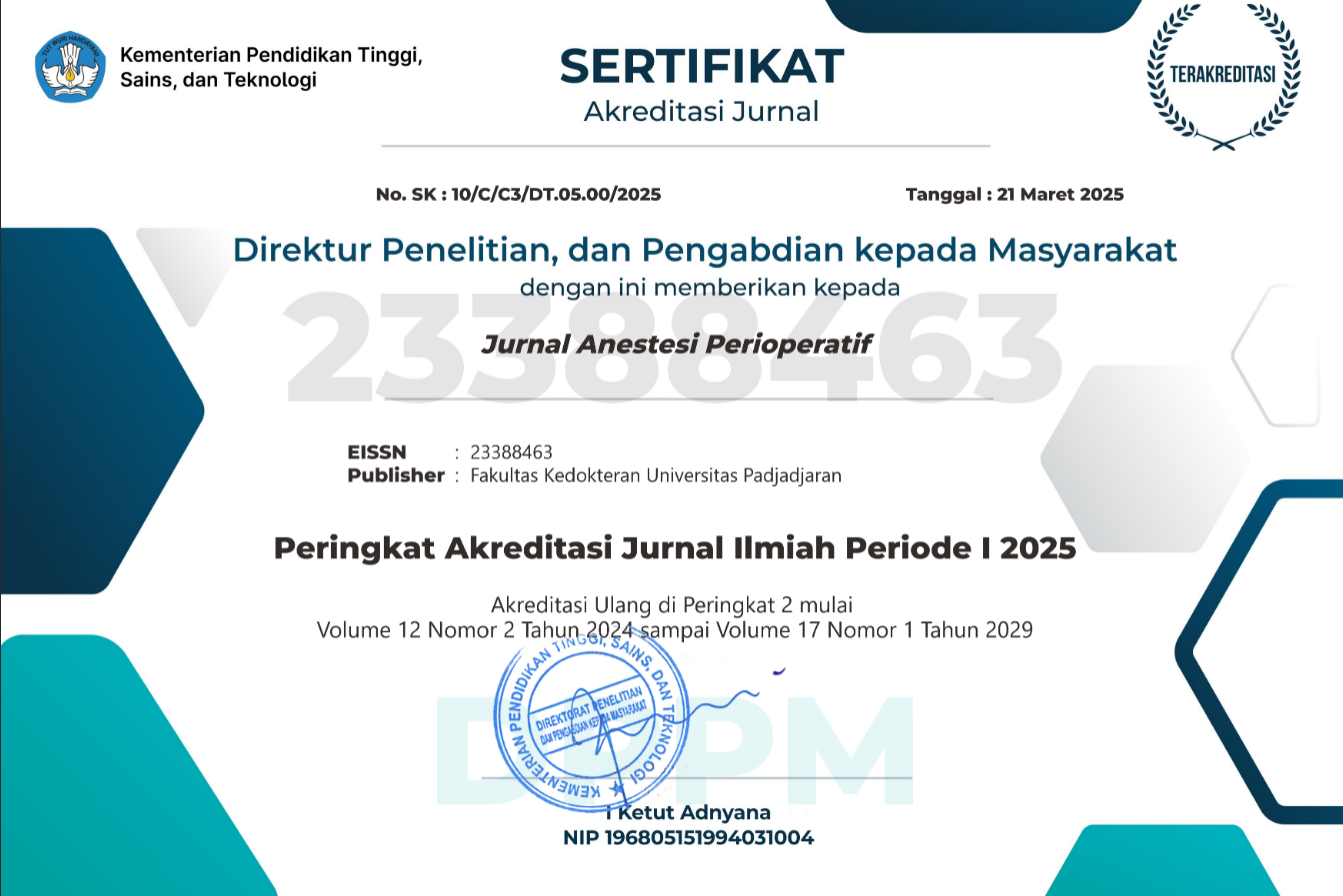Angka Mortalitas dan Faktor yang Memengaruhi pada Pasien Trakeoesofageal Fistula (TEF) yang Menjalani Operasi di RSUP Dr. Hasan Sadikin Bandung
Abstract
Trakeoesofageal fistula (TEF) merupakan kelainan esofagus yang bersifat kongenital ditandai dengan fistula antara trakea dan esofagus yang merupakan koneksi abnormal yang dapat disertai putusnya antara distal dan proksimal esofagus. Insidensi TEF kongenital mencapai 1:2.400‒4.500 kelahiran hidup. Tujuan penelitian ini mengetahui angka mortalitas dan faktor yang memengaruhi pada pasien TEF yang menjalani operasi di RSUP Dr. Hasan Sadikin Bandung pada tahun 2010–2015. Metode penelitian ini bersifat deskriptif yang dilakukan secara retrospektif terhadap 35 rekam medik pasien TEF yang menjalani operasi di RSUP Dr. Hasan Sadikin Bandung pada tahun 2010‒2015. Hasil penelitian ini menunjukkan angka mortalitas pascaoperasi pasien TEF sebesar 19 dari 34 dan mortalitas tertinggi terjadi pada perempuan 7 dari 12, bayi lahir lahir prematur 5 dari 5, berat badan lahir kurang dari 1.500 gram 1 dari 1, TEF tipe C 19 dari 32, riwayat persalinan di bidan/puskesmas 9 dari 11, disertai kelainan kongenital penyerta selain kelainan anorektal, usia saat operasi lebih dari 7 hari 15 dari 17, penyulit preoperatif lebih dari satu, lama operasi lebih dari 3 jam, tidak dilakukan ekstubasi 15 dari 20, kenaikan berat badan lebih dari 10% 14 dari 18, leakage pascaoperasi dan faktor penyulit pascaoperasi lebih dari satu. Simpulan Angka mortalitas pasien TEF yang menjalani operasi di RSUP Dr. Hasan Sadikin Bandung pada tahun 2010–2015 sebanyak 54,3%.
Kata kunci: Mortalitas pascaoperasi, operasi, trakeoesofageal fistula
Mortality and The Influencing Factors of Trakeoesofageal Fistula (TEF)Patients which Operated in Dr. Hasan Sadikin General Hospital Bandung
Tracheoesophageal fistula (TEF) is a disorder of the esophagus that is characterized by congenital fistula between the trachea and esophagus wich is an abnormal connection that can be accompanied by a break between the distal and proximal esophagus. The incidence of congenital TEF reached 1:2,400‒4,500 live births. The purpose of this study to determine mortality and factors affecting mortality in patients TEF in Dr. Hasan Sadikin General Hospital Bandung in 2010‒2015. This research method was descriptive retrospectively of 35 patients taken from the medical records underwent surgery TEF in Dr. Hasan Sadikin Central Hospital Bandung in 2010‒2015. Results of this study showed a mortality rate of postoperative patients TEF rate of 19 from 34 and the highest mortality among women 7 from 12, premature birth, birth weigth less than 1,500 g, TEF type C 19 from 36, childbirth history at the midwife 9 from 11, congenital abnormalities other than anorectal disease, age at surgery of more than 7 days 15 from 17, preoperative complications more than one, the operating time of more than 3 hours, do not extubation 15 from 20, weight gain more than 10% 14 from 18, the leakage postoperative and more than one complications postoperative factors. In conclusion, mortality of trakeoesofageal fistula (TEF) patients which operated in Dr. Hasan Sadikin General Hospital Bandung in 2010–2015 was 54.3%.
Key words: Postoperative mortality, operatif, tracheoesophageal fistula
Keywords
Full Text:
PDFReferences
Skripochnik E, Ashton R, Negari-Miandoab S. Esophagobronchial fistula following corrosive injury of esophagus: 2 cases with different etiology but similar presentation. Open Cardiovasc Thoracic Surg. 2013;6:16–8.
Foroulis C, Nana C, Kleontas A, Tagarakis G, Karapanagiotidis G, Zarogoulidis P, dkk. Repair of post-intubation tracheoesophageal fistulae through the left pre-sternocleidomastoid approach: a recent case series of 13 patients. Thoracic Dis. 2015;7(S1):S20–6.
Davari H, Hosseinpour M, Nasiri G, G K. Mortality in esophageal atresia: assessment of robable risk factors (10 years’ experience). Res Med Sci. 2012;17:540–2.
Rays O. Congenital tracheoesophageal fistula with or without esophageal atresia, King Abdulaziz University Hospital Experience over 15 Years. King Abdulaziz University-Med Sci. 2010;17(4):59–72.
Ciornei M, Savu B, Hanganu E, Popa DE, Burlea M. Prognostic factors in the early postoperative outcome of esophageal atresia: the experience of a tertiary center over a 5 years period. Pediatr Surg. 2015 January-June;18(69–70):71–4.
Trivedi H, Vanzar P. Congenital tracheooesophageal fistula. Nat Otorhinolaryngol Head Neck Surg. 2014;2(11):9–11.
Tandon R, Sharma S, Sinha S, Rashid K, Dube R, Kureel S, dkk. Esophageal atresia: factors influencing survival-experience at an Indian tertiary centre. Associat Pediatr Surg. 2008;13(1):2–6.
Kohli M, T M, Malik A, Singh S. Factors affecting anaesthetic management and early post-perative outcome in patients with esophageal atresia and tracheo-esophageal fistula: a prospective study. Internet Anesth. 2010;28(2):1–5.
Mathai S, Raju C, Kanitkar C. Management of respiratory distress in the newborn. MJAFI. 2007;63:269–72.
Butterworth JF, Mackey DC, Wasnick JD. Pediatric anesthesia. Dalam: Butterworth JF, Mackey DC, Wasnick JD, penyunting. Morgan & Mikhail’s clinical anesthesiology. Amerika: McGraw-Hill Education, LLC; 2013. hlm. 899–901.
Seo J, Kim D, Kim A, Kim D, Kim S, Kim I, dkk. An 18-year experience of trahheoesophageal fistula and esophageal atresia. Korean Pediatr. 2010;53(6):705–10.
Knottenbelt G, Costi D, Stephens P, Beringer R, Davidson A. An audit of anesthetic management and complications of tracheo-esophageal fistula and esophageal atresia repair. Pediatr Anesthesia. 2012;22:268–74.
Anwar-ul-Haq, Ubaidullah, Akhter N, Samiullah, Javeria, Jan IA, dkk. Factors affecting survival in patients with oesophageal atresia and tracheo-oesophageal fistula. Ayub Med College Abbottabad. 2009;21(4):129–33.
Castilloux J, Noble A, Faure C. Risk factors for short- and long-term morbidity in children with esophageal atresia. Pediatrics. 2010;156(5):1–10.
Osia S, Hadipour A, Moshrefi M, Mirzapor M. Esophageal Atresia: 13 years’ Experience in Amirkola Children’s Hospital, North of Iran. Caspian J Pediatr. 2015;1(1):22–4.
Tokhais T, Zamakhzhary M, Aldekhayel S, Mandora H, Sayed S, Alharbi K, dkk. Thoracoscopic repair of tracheoesophageal fistulas: a case–control matched study. Pediatric Surg. 2008;43:805–9.
Ketharanathan N, McCulloch M, Wilson C, Rossouw B, Salie S, Ahrens J, dkk. Fluid overload in a South African Pediatric Intensive Care Unit. Tropic Pediatri. 2014;60(6):428–33.
Al-Salem A, Kothari M, Oquaish M, Khogeer S, Desouky M. Morbidity and mortality in esophageal atresia and tracheoesophageal fistula: a 20-year review. Annals Pediatr Surg. 2013;9(3):93–8.
DOI: https://doi.org/10.15851/jap.v5n2.1111
Article Metrics
Abstract view : 2484 timesPDF - 4621 times
This Journal indexed by

JAP is licensed under a Creative Commons Attribution-NonCommercial 4.0 International License
View My Stats



